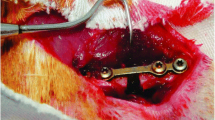Summary
Two series of controlled experiments were carried out to investigate the effect of intermittent local heating on fracture healing in the distal tibia of the rabbit. In the first series, the distal tibia was fractured in a reproducible manner and then treated by compression plate fixation. Nine animals received intermittent local heating around the fracture site for 6 weeks postoperatively in comparison with 5 control animals. The mechanical strength of the healed tibia was then measured in a standardized 3-point bend test. Intermittent local heating produced stronger bones than the untreated controls in 6 of the 9 cases, a result which was marginally significant (P=0.055). In the second series of experiments, a reproducible bone defect was created by drilling a 2 mm diameter hole through the distal tibia; compression plate stabilization was not required. Fourteen animals received intermittent local heating around the fracture site for 3 weeks postoperatively in comparison with 7 control animals. Intermittent local heating produced stronger bones than the untreated controls in 8 of the 14 cases, a result which was not significant (P>0.1). It is concluded that intermittent local heating of the type studied has too small an effect on accelerating the rate of fracture repair to be clinically useful.
Résumé
Deux séries d'expérimentations contrôlées ont été effectuées dans le but d'évaluer les effets de l'échauffement local intermittent sur la consolidation des fractures au niveau de l'extrémité distale du tibia du lapin. Dans la première série, le tibia était fracturé de façon reproductible et traité par mise en place d'une plaque à compression. Neuf animaux furent soumis à un échauffement intermittent a niveau du foyer de fracture pendant six semaines post-opératoires et comparés à cinq animaux de contrôle. La résistance mécanique du tibia consolidé fut alors mesurée grâce à un test de flexion standardisé. L'échauffement local intermittent détermina des os plus solides que ceux des animaux non traités dans six cas sur neuf. Ce résultat était légèrement significatif (P=0,055). Dans la deuxième série, on créa une perte de substance osseuse reproductible en forant un trou de 2 mm de diamètre au travers du tibia, à sa partie distale. On n'utilisa pas de plaque de fixation. Quatorze animaux bénéficièrent d'un échauffement intermittent du foyer de fracture pendant trois semaines postopératoires et furent comparés à sept animaux de contrôle. L'échauffement local intermittent produisit des os plus solides que ceux des témoins dans huit des quatorze cas, ce qui n'était pas significatif (P>0,1). On peut en conclure que l'échauffement local intermittent, selon les modalités étudiées, n'a qu'un trop faible effet sur l'accélération du temps de consolidation des fractures pour pouvoir être utilisé en clinique.
Similar content being viewed by others
References
Andrews IM (1985) The design of a harness and umbilical system for electrical monitoring of unrestrained rabbits. Animal Technol 36:199–201
Bundy RE, Spagnoli HH, Schwartz EM, White RE (1965) The effect of locally applied heat on bone growth. J Dental Res 44:541–548
Doyle JR, Smart BW (1963) Stimulation of bone growth by short-wave diathermy. J Bone Joint Surg 45 [Am]:15–24
Eagleson WM, Deckert KI, Townsend EE, Arnott JR (1967) The effect of heat on the healing of fractures: a preliminary experimental report. Can Med Assoc J 97:274–280
Flecknell PA (1984) The relief of pain in laboratory animals. Laboratory Animals 18:147–160
Granberry WM, Janes JM (1963) The lack of effect of microwave diathermy on rate of growth of bone of the growing dog. J Bone Joint Surg 45 [Am]:773–777
Janes JM, Musgrove JE (1950) Effect of arteriovenous fistula on growth of bone. Surg Clin North Am 30:1191–1200
Richards V, Stofer R (1959) The stimulation of bone growth by internal heating. Surgery 46:84–96
Ring PA, Lee J (1958) The effect of heat upon the growth of bone. J Pathol Bacteriol 75:405–412
Royal Statistical Society (1978) The GLIM system. Release 3. Numerical Algorithms Group, Oxford
Speed K, Fell EH (1939) Temperature-controlled healing of experimental fractures. J Bone Joint Surg 21:1005–1011
Walter SD (1980) Matched case-control studies with a variable number of controls per case. Appl Statistics 29:172–179
Weinberg ED, Ward GE (1934) Diathermy and regeneration of bone. Arch Surg 28:1121–1129
Author information
Authors and Affiliations
Rights and permissions
About this article
Cite this article
Wootton, R., Jennings, P., King-Underwood, C. et al. The effect of intermittent local heating on fracture healing in the distal tibia of the rabbit. International Orthopaedics 14, 189–193 (1990). https://doi.org/10.1007/BF00180127
Issue Date:
DOI: https://doi.org/10.1007/BF00180127




